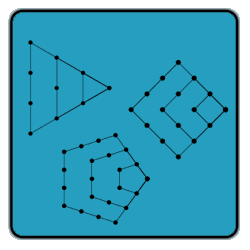
For starters, I will explain that a triangle number is any number X, such that if X dots were aranged in a a shape the first row would have one dot, the second two dots, the third three and so on, forming a triangular shape.
The first few triangle numbers are 1, 3, 6, 10, 15, 21, 28, 36, 45, 55, 66, 78, 91, 105, 120. In other words you start by adding one, then two then, three etc. The formula for these is (n(n+1))/2.
Next square numbers which we learn as N squared. But they can also be expressed as ((n(n+1))/2) + ((n(n-1))/2). Here the first few are: 1, 4 ,9 ,16, 25, 36, 49. In this case, instaed of adding 1 then 2 then 3 you add 1 then 3 then 5 then 7 (i.e. every other number).
Next are pentagonal numbers which are also comprised of dots where the Nth pentagonal number is the number of dots in the figure. The first few are: 1, 5, 12, 22, 35, 51. Notice how first you add 1 then 4 then 7 then 10 then 13 (i.e. every third number). The formula is ((n(n+1))/2) + ((2)(n(n-1))/2).
Can you find a pattern in N-gons and prove it?
We're given that a triangular shape (sides, s, = 3) has the formula: (n(n+1)/2)
If I express our triangular shape as a series of rows, with entries per row to indicate number of points added for each additional expansion, it might looks something like this:
#
##
###
####
#####
(etc.)
What can we see about the square (s = 4), in a similar depiction:
#
###
#####
#######
#########
(etc.)
Can we see something in this? Well:
# = # + nothing
### = ## + #
##### = ### + ##
####### = #### + ###
######### = ##### + ####
(etc.)
So, each row of our square numbers is simply a triangular number, plus the triangular number of one size smaller.
So, the equation is:
(n(n+1)/2) + ((n-1)n/2)
(the second half derived from passing 'n-1' instead of 'n' into the original equaltion)
What about the pentagonal (s = 5) numbers?
# = # + nothing
#### = ## + # + #
####### = ### + ## + ##
########## = #### + ### + ###
############# = ##### + #### + ####
(etc.)
The pentagonal numbers are the triangular numbers, with TWO one-size-smaller sets of triangular numbers added to it:
(n(n+1)/2) + 2*((n-1)n/2)
 For starters, I will explain that a triangle number is any number X, such that if X dots were aranged in a a shape the first row would have one dot, the second two dots, the third three and so on, forming a triangular shape.
For starters, I will explain that a triangle number is any number X, such that if X dots were aranged in a a shape the first row would have one dot, the second two dots, the third three and so on, forming a triangular shape.



